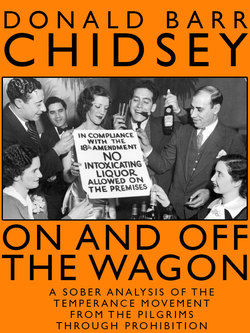Читать книгу On and Off the Wagon - Donald Barr Chidsey - Страница 4
На сайте Литреса книга снята с продажи.
ОглавлениеCHAPTER ONE
Hiss the Villain
The corner saloon is the villain of this story. There are many in America who remember it, and many who wince when they do. It was a mysterious, maleficent, awesome institution, almost flamboyantly wicked. Children were taught never to loiter near it and under no circumstances, even when passing, to peer under the swinging doors. They did both, just to get a glimpse of the dim interior, flyblown mirrors, men’s feet on a brass rail, the sawdust, the spittoons. Now and again a man would lurch through those doors, coming or going, and then the children would scatter, scampering away, afraid of the kind of men who patronized the corner saloon. But the children always came back, for the place was endlessly fascinating.
Women walked blocks out of their way to avoid passing a saloon. In the cities a lady might have to pass half a dozen such dives on her way downtown to do her shopping. She would walk fast, turning her head a little aside, for the language that emerged from the corner saloon was never intended for a female audience. Men were not allowed to talk that way on the sidewalk.
There were men who did not pause in passing the saloon or hasten their step, but who shook a sad head and clucked their tongues, wondering how the American people could continue to tolerate such places. These men were not long-nosed, skinny- necked galoots who carried tightly folded umbrellas, such as Rollin Kirby depicted in his New York World cartoons, men who gazed upon their neighbors with a jaundiced eye and whose mouths seemed filled with lemon juice. Most were decent, sensible people who deplored the saloon because it was a deplorable place and who were determined to do whatever they could to abolish it.
The most notable thing about the saloon was its stink. It was a fusty, musty odor, damp and clammy, an odor compounded of sawdust, tobacco juice, malt, metal polish, and whiskey. Though the word “saloon” was abhorrent to all right-thinking people, it had not always been so. The inns and ordinaries of American colonial days were called taverns and taprooms, but these shops had the reputation of being loafing grounds, the meeting places of idlers and drunkards, so that when “saloon” drifted into the language, from France by way of England, it was seized upon by the purveyors of spirits and malt drinks as an excellent and elegant substitute. “Saloon” was high-toned. Nothing dreadful could ever happen in a “saloon.”
Toward the end of what was dubbed the Dry Decade—though it lasted almost fourteen years, from 1920 to 1933—when repeal was faintly visible on the horizon and men’s hearts beat faster in the hope of obtaining unpoisoned booze, even the most stalwart of the wets—men like A1 Smith of New York and Governor Albert C. Ritchie of Maryland—protested that, no matter what might happen to the Eighteenth Amendment, the old-fashioned saloon would never come back. Nor has it—by that name. Many saloons today call themselves bars and cocktail lounges; but others, in a calculated attempt to achieve an air of respectability and nostalgia, are called taverns or taprooms.
So we have come full circle. It might be interesting to examine this phenomenon. The stench has gone, admittedly, but could it be that the spirit of the old corner saloon still lingers on?
